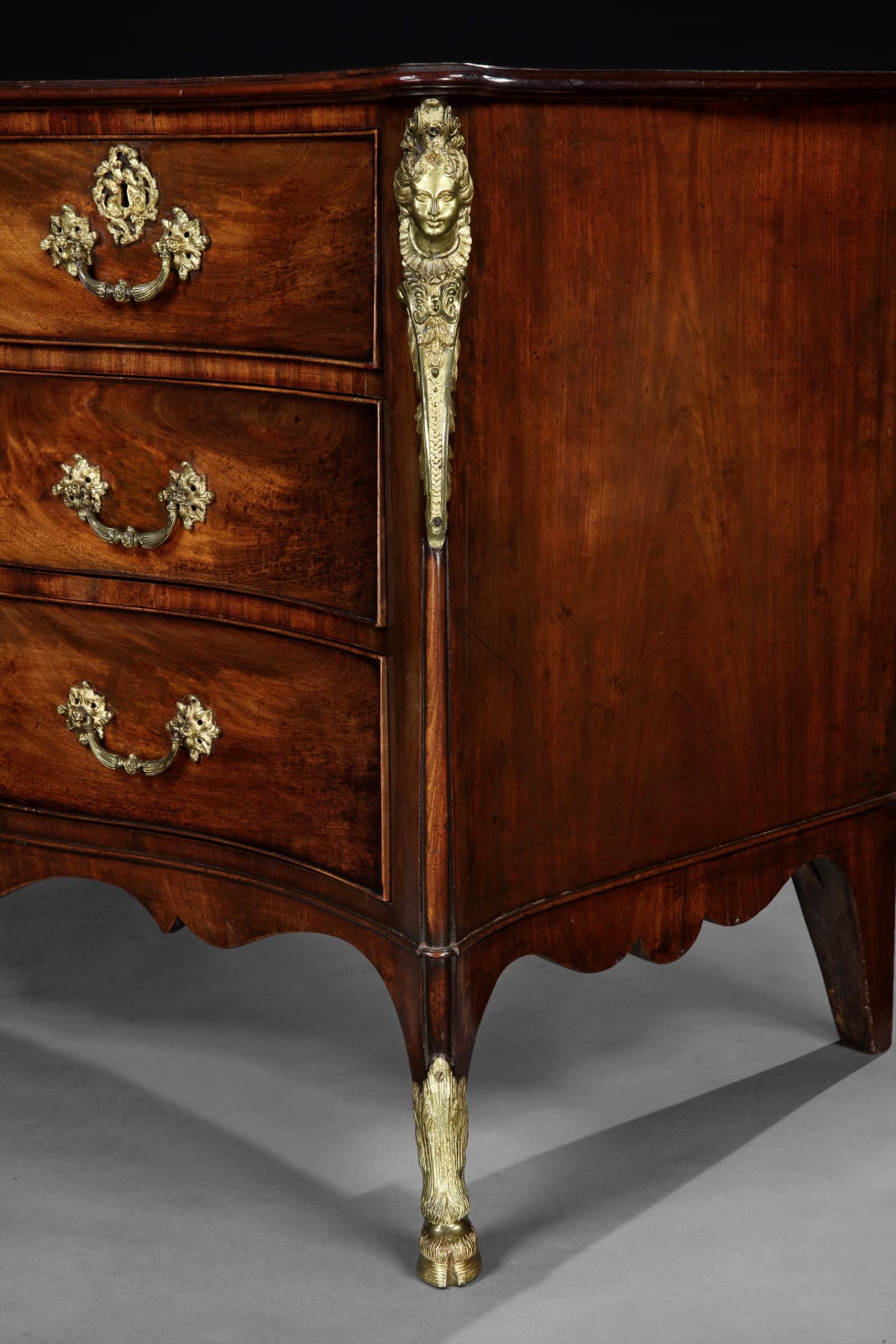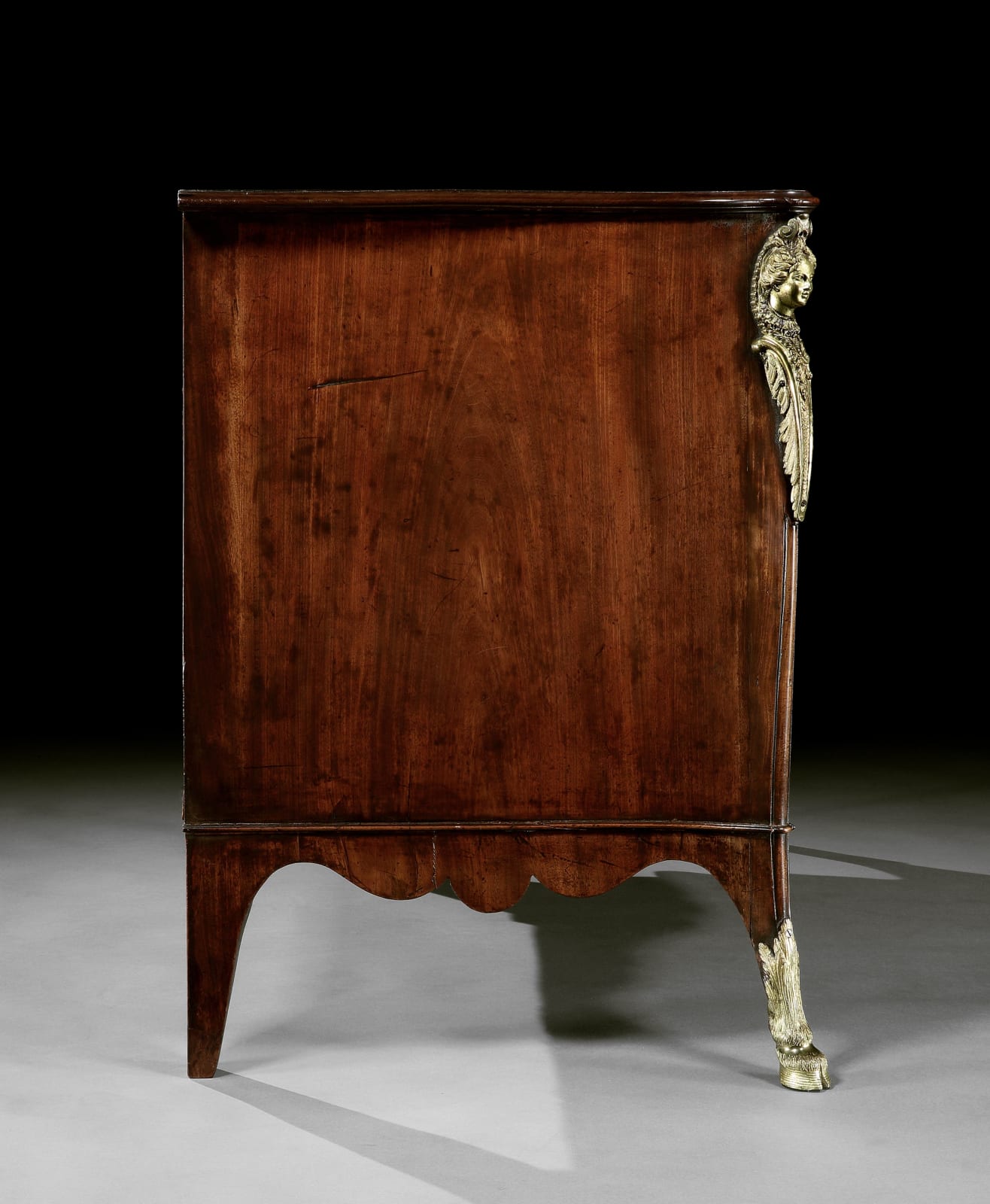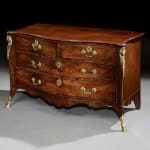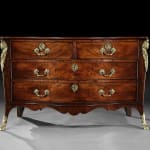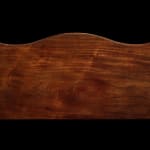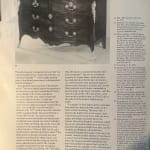A GEORGE III MAHOGANY COMMODE ATTRIBUTED TO JOHN COBB
Width: 55.5” / 141cm
Depth: 26.75” / 68cm
Further images
Provenance
Possibly commissioned by Fulwar Craven, 4th Baron Craven (c. 1700-64) or his nephew William Craven, 5th Baron Craven (1705–1769) for Coombe Abbey, Warwickshire
Or, possibly made for George William Coventry (1722-1809), 6th Earl of Coventry for Croome Court, Worcestershire and by descent with the Earls of Coventry at Croome until the 9th Earl, when the commode possibly moved to Coombe Abbey following his marriage to Lady Blanche Craven, daughter of 2nd Earl of Craven
By repute the Earls of Craven at Coombe Abbey, Warwickshire until 1923
Sold Sotheby’s, 14th June 1985, lot 90
Partridge (Fine Arts) Ltd., London, 1986
Literature
L. Wood, Catalogue of Commodes (London: 1994), pp. 43-53
G. Beard and C. Gilbert, Dictionary of English Furniture Makers, 1660-1840 (London: 1986), pp. 181-4
COMPARE
The present commode is one of six other commodes of this model:
Example in the Metropolitan Museum of Art, New York (Accession No. 61.242.1)
Example at Blickling Hall, Norfolk (NT 354321)
Example from the collection of H. Percy Dean, illus. Macquoid, P., The Age of Mahogany (London, 1906), pl. X and Edwards, R. & Macquoid, P., The Dictionary of English Furniture, Vol. II (London, 1954), p. 115, fig. 10, later in the collection of Sir John Ward and said to have been formerly in the collection of Sir Maurice Bromley-Wilson, c.f. Cescinsky, Herbert, ‘The collection of the Hon. Sir John Ward, K.C.V.O.’, Part IV, Connoisseur (August 1921), pp. 195-7, fig. III
Example from the collection of Sir Archibald Edmonstone (1894–1954), 6th Baronet, sold Christie’s London, 27th March 1958, lot 82
Example from the collection of Mrs. Langdale Smith, sold Christie’s London, 24th October 1957, lot 87; thereafter the collection of Michael Behrens, Esq., sold Christie’s London, 6th July 1989, lot 162 (GBP £82,500); with Partridge (Fine Arts) Ltd., London; sold Christie’s New York, 16th April 2002 (USD $163,500)
Example sold Neal Auction Company, New Orleans, December 1999 (USD $275,000)
Publications
L. Wood, Catalogue of Commodes (London: 1994), p. 52, fig. 8
Partridge, Recent Acquisitions 1986, no. 20
A George III mahogany ormolu-mounted serpentine commode attributed to John Cobb, the moulded edge top above two short and two long graduated draws flanked by female term-mounted keeled stiles and standing on ormolu cloven-hoofed splayed bracket feet.
This commode, executed in the pittoresque or French manner in circa 1765, is attributed to the royal cabinet-maker John Cobb. It is one of a group of closely-related commodes attributed to Vile & Cobb discussed by Lucy Wood in section one of her Catalogue of Commodes, where the present commode is illustrated.
The commodes in the group are all characterised by serpentine form, high quality mahogany timbers and rich Régence-pattern ormolu mounts, comparing in general conception with the only documented Cobb commission anchoring the group, the single mahogany and ormolu-mounted serpentine commode supplied to James West for Alscot Park in 1766 for £16.
A sub-group of the main group of commodes, which includes the present example, is related by the common feature of female mask style mounts. This includes the examples at Burghley House, Blickling Hall (NT 354356.1 & NT 354356.2), Woburn Abbey and the Lady Lever Art Gallery, whose female ormolu masks are also all ornamented in the same manner with rocaille collars, C-scrolls, acanthus leaves, gadrooning, strapwork, husks and lapped lambrequins.
A smaller number still – only seven examples including the present commode are known – feature splayed legs with hoof feet, the other commodes in this sub-group featuring square bracket feet mounted with acanthus leaves. These are from the (1) Metropolitan Museum of Art (Accession No. 61.242.1), (2) Blickling Hall (NT 354321), (3) H. Percy Dean Collection, (4) Sir Archibald Edmonstone Collection, (5) Mrs Langdale Smith Collection and one (6) that sold Neal Auction Company in 1999. The hooves indicate a more mature Rococo style, according with the handles and escutcheons on the present commode which, like the Dean and Edmonstone examples but unlike the Blickling and Met. examples, are pierced, again indicating an updated, more refined Rococo design.
The Blickling commode, and the four others that remain at the house, were almost certainly covered by a payment by the 2nd Earl of Buckinghamshire of £86.5s.9d. to ‘Vile & Cobb cabinet-makers’ in August 1762. Not only practically confirming the authorship, this provides a clue as to the date of the present commode. Yet, with its updated Rococo metalware it likely dates to a few years later, perhaps 1764 onwards, suggesting the present example was the work of John Cobb alone, his partner William Vile retiring in that year.
Renowned for his designs in the French taste, John Cobb, alongside his St. Martin’s Lane neighbour Thomas Chippendale, led the synthesis of French and English styles so popular in England during the 1750s and 60s.
Apprenticed in 1729 in Norwich, Cobb (c.1715-78) first appears in the London Directory in 1750 shortly before he entered partnership with William Vile in 1751. Vile and Cobb established a highly successful business and were with Chippendale the most accomplished cabinet-makers of the mid-Georgian period. Their work is characterised by confident lines and well-chosen, high-quality timbers. They were appointed cabinet-makers to George III in 1761 and together supplied a series of celebrated pieces to Kensington Palace, St. James’s Palace and the Queen’s House, now Buckingham Palace.
Cobb himself was an interesting man. A ‘singularly haughty character’, he was described as ‘one of the proudest men in England’. J. T. Smith in Nollekens and his Times recorded how Cobb ‘in full dress of the most superb and costly kind, strutted through his workshops giving orders to his men’. Smith also relates George III’s placing Cobb in second place through annoyance at his pomposity and imperious delegation of duties to his man Jenkins.
Quite in keeping with his character, in 1772 Cobb was implicated with others, including James Cullen, in the smuggling of furniture from France by the use of the diplomatic bag of the Venetian Resident, Baron Berlindis and the Neapolitan Minister, Count Pignatelli, with the aim of evading import duty.
Charismatic, Cobb also had the distinction of being the son-in-law of the great Giles Grendey, perhaps the leading maker of walnut and japanned furniture in the first half of the eighteenth-century. On 31st March 1755 he had married Sukey Grendey, Giles’ fourth daughter. At her death he was remarried to Mary Babel, the widow of Pierre (Peter) Babel, a papier mâché frame maker, on 24th February 1772, by license at St. Paul’s Covent Garden, Cobb then described as a cabinet maker and salon decorator. Mary outlived him and married for a third time.
This commode is likely the work of John Cobb alone, following his continuing in the trade for thirteen years after the retirement of his partner Vile in 1764. During this period, Cobb supplied furniture to many aristocratic clients across the country, including the 6th Earl of Coventry at Croome Court, his largest commission.
The present commode is reputed to have descended with the Earls of Craven at Coombe Abbey, Warwickshire. It was therefore possibly commissioned by Fulwar Craven, 4th Baron Craven (c. 1700-64) or his nephew William Craven, 5th Baron Craven (1705–1769), whose great nephew, also William, 7th Baron (1770–1825), was made 1st Earl of Craven, of the second creation, in 1801. Both the 4th and 5th Barons are known to have commissioned mahogany furniture of superlative quality from preeminent London cabinet-makers in the mid eighteenth century, and several important works with a Craven provenance have appeared at auction in the twentieth century.
Alternatively, it is possible that the present commode was part of the magnificent Cobb commission for the 6th Earl of Coventry for Croome Court and shared the destiny of the celebrated clothes presses made by Cobb to a design by Robert Adam for Croome, which were sold from Coombe in April 1923. They are presumed to have come to Coombe from Croome through the marriage of the 9th Earl of Coventry to Lady Blanche Craven, daughter of the 2nd Earl of Craven, and it is conceivable that the present commode made the same journey.
To date it has not been possible to identify the present commode in any of the known public auctions of Craven property in the twentieth century, but it is certainly of the same calibre in terms of design, material and artistry as the documented Craven works.
Historically, commodes from this group have achieved significant auction prices. In addition to the examples of the same model as the present commode already cited, a closely related commode from the Lucy Wood group with the same espagnolette mask mounts supplied to the 5th Duke of Bolton for Hackwood Park sold Christie’s New York, 8th July 1999 for GBP £199,500, and another of identical model supplied to John, 2ndEarl of Ashburnham for Ashburnham Place, Sussex in circa 1760-61, sold Christie’s New York, 19th October 2000 for USD $171,000.
Additionally, another commode from the group, which relates closely to others of the same model formerly in the collection of Mrs Venetia Gairdner (illus. Wood, Catalogue of Commodes, p. 53, fig. 30), with provenance of R. A. Lee sold Christie’s New York, 19th April 2001, USD $446,000.


